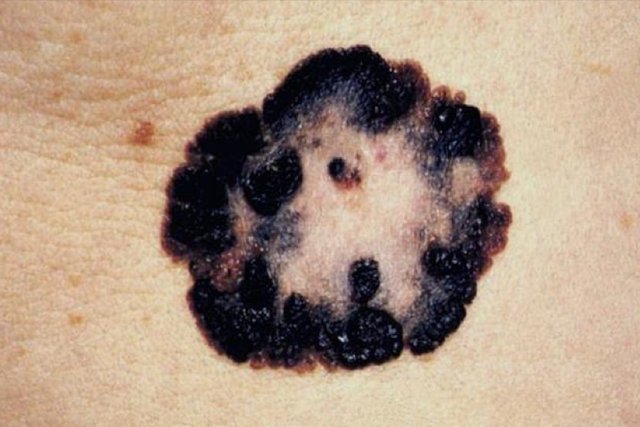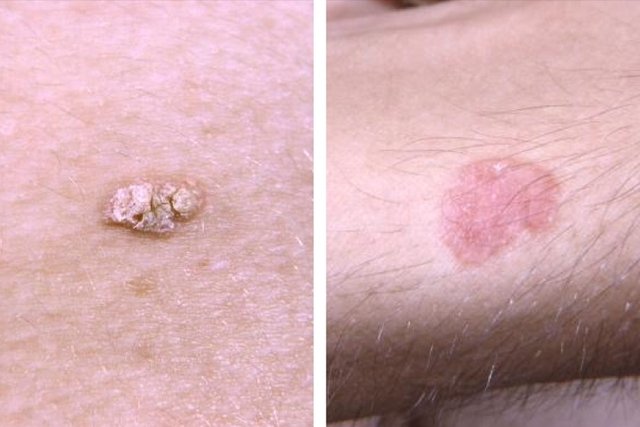Skin cancer treatment can be done with surgery, radiotherapy, chemotherapy or immunotherapy, for example, which varies depending on the type of tumor, whether melanoma or non-melanoma, as well as the stage of the disease.
Skin cancer is a malignant tumor caused by mutations in cells that begin to multiply uncontrollably, and can be identified through signs such as a lesion with different colors, irregular edges and increases in size over time, for example. Know how to identify the signs of skin cancer.
Skin cancer treatment is carried out by a dermatologist and/or oncologist and radiologist, and should be started as soon as possible to increase the chances of a cure. Therefore, it is recommended to always be aware of changes in the skin, which may indicate the emergence of cancer.

Main treatments for skin cancer
Depending on the characteristics of the lesion, the type of cancer, the size and the person’s general condition, different types of treatment may be recommended:
1. Surgery
Surgery is the initial treatment for melanoma or non-melanoma skin cancer, such as basal cell carcinoma, squamous cell carcinoma, or actinic keratosis. Check out the main types of skin cancer.
This surgery can be performed by the doctor using different techniques, which are:
- Simple removal surgery: It is the most commonly used type of surgery, in which the entire lesion caused by cancer and some of the surrounding healthy tissue is removed;
- Mohs micrographic surgery: It is used especially for skin cancer on the face, as it is made to remove thin layers of skin until all cancer cells are removed. This way it is possible to avoid removing too much healthy tissue and leaving very deep scars;
- Tangential excision or excision shaving: it is done by scraping the surface of the skin with a blade to remove the abnormal area of skin;
- Electro Curettage: the tumor is removed with a curette, which is a spoon-shaped instrument, and then a small electric current is applied to stop the bleeding and eliminate any cancer cells that may have remained in the skin;
- Cryosurgery: It is used in cases of carcinoma in situ, in which the lesion is well defined and it is possible to freeze it until all malignant cells are eliminated.
Surgical treatment of non-melanoma skin cancer or melanoma in early stages can be done with surgery alone.
However, in the case of melanoma or non-melanoma skin cancer in advanced stages, the doctor may complement surgery with other treatments.
If you need treatment for skin cancer, make an appointment with an oncological dermatologist in the nearest region:
Taking care of your health has never been easier!
2. Radiotherapy
Radiotherapy for skin cancer is normally used in more advanced cases of non-melanoma skin cancer such as basal cell carcinoma and squamous cell carcinoma.
This type of treatment may also be recommended by the oncologist for melanoma or as palliative treatment for this type of skin cancer, to alleviate symptoms and improve quality of life.
Radiotherapy is carried out using a machine, placed near the affected area, which emits radiation capable of destroying tumor cells, requiring several sessions of radiotherapy, which can cause side effects such as itching, irritation or burns to the skin. Check out what to do to alleviate the side effects of radiotherapy.
3. Chemotherapy
Chemotherapy for skin cancer may be indicated to eliminate remaining tumor cells, as they act by preventing the division and multiplication of cancer cells.
This type of treatment can be done by injecting medicine directly into the vein, such as dacarbazine, carboplatin, cisplatin or paclitaxel, or, in some cases, it can also be done by taking pills, such as temozolomide, for example.
However, chemotherapy acts on all dividing cells in the body, such as hair follicle or blood cells that are constantly renewed, which can cause side effects such as hair loss or a decrease in the body’s defense system, increasing the risk of infections, for example.
4. Target therapy
Targeted therapy uses drugs to help the immune system specifically identify and attack cancer cells, having little effect on the body’s normal cells.
Some drugs used in targeted therapy for skin cancer are vemurafenib, encorafenib, binimetinib, imatinib or nilotinib, for example.
In some cases, targeted therapy can be combined with radiotherapy or chemotherapy to increase the chance of cure.
Some side effects of targeted therapy for skin cancer may be allergic reactions, difficulty breathing, increased blood pressure, acne, fever or diarrhea, for example.
5. Immunotherapy
Immunotherapy is also another type of treatment that may be recommended by an oncologist for skin cancer.
Some examples of immunotherapy for skin cancer are:
- Pembrolizumab, nivolumab, ipilimumab or cemiplimab, applied directly into the vein;
- Injectable interferon for squamous cell carcinoma;
- Topical imiquimod in cream form for basal cell carcinoma.
This type of treatment helps to increase the immune system’s response against cancer cells, which can lead to a decrease in the size of the cancer or delay its growth.
Immunotherapeutic drugs can be used together with chemotherapy or radiotherapy, in cases of skin cancer that have been previously treated but have reappeared, or even used in more advanced stages or with metastases.
Signs of improvement and worsening
The reduction of lesions and the non-appearance of new lesions are indicative that the treatment was effective, and is therefore a sign of improvement in the cancer, being more common in cases where the cancer is identified and treated at an early stage.
Signs of worsening
When treatment is not started early or is at a very advanced stage, signs of worsening include the appearance of new skin lesions, pain at the site of the lesion and excessive tiredness, for example.
Furthermore, in the case of metastases, other symptoms may appear that vary according to the affected organ.

Sign up for our newsletter and stay up to date with exclusive news
that can transform your routine!
Warning: Undefined array key "title" in /home/storelat/public_html/wp-content/plugins/link-whisper-premium/templates/frontend/related-posts.php on line 12
Warning: Undefined array key "title_tag" in /home/storelat/public_html/wp-content/plugins/link-whisper-premium/templates/frontend/related-posts.php on line 13




